英语教学论复习
- 格式:doc
- 大小:103.50 KB
- 文档页数:10
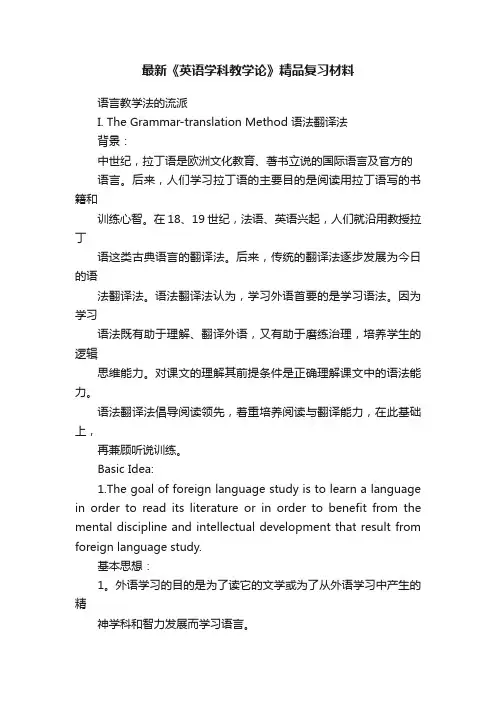
最新《英语学科教学论》精品复习材料语言教学法的流派I. The Grammar-translation Method 语法翻译法背景:中世纪,拉丁语是欧洲文化教育、著书立说的国际语言及官方的语言。
后来,人们学习拉丁语的主要目的是阅读用拉丁语写的书籍和训练心智。
在18、19世纪,法语、英语兴起,人们就沿用教授拉丁语这类古典语言的翻译法。
后来,传统的翻译法逐步发展为今日的语法翻译法。
语法翻译法认为,学习外语首要的是学习语法。
因为学习语法既有助于理解、翻译外语,又有助于磨练治理,培养学生的逻辑思维能力。
对课文的理解其前提条件是正确理解课文中的语法能力。
语法翻译法倡导阅读领先,着重培养阅读与翻译能力,在此基础上,再兼顾听说训练。
Basic Idea:1.The goal of foreign language study is to learn a language in order to read its literature or in order to benefit from the mental discipline and intellectual development that result from foreign language study.基本思想:1。
外语学习的目的是为了读它的文学或为了从外语学习中产生的精神学科和智力发展而学习语言。
2.Reading and writing are the major focus; little or no systematic attention is paid to speaking or listening.2。
阅读和写作是主要的焦点,很少或根本没有系统的关注是听或说。
3. Vocabulary selection is based solely on the reading texts used. In a typical Grammar-Translation text, a list of vocabulary items is presented with their translation equivalents. Words are taught through bilingual word lists, dictionary study and memorization. 3。
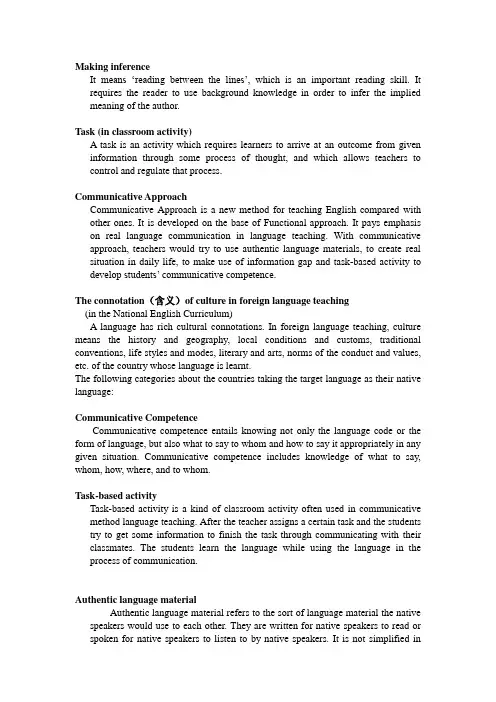
Making inferenceIt means ‘reading between the lines’, which is an important reading skill. It requires the reader to use background knowledge in order to infer the implied meaning of the author.Task (in classroom activity)A task is an activity which requires learners to arrive at an outcome from giveninformation through some process of thought, and which allows teachers to control and regulate that process.Communicative ApproachCommunicative Approach is a new method for teaching English compared with other ones. It is developed on the base of Functional approach. It pays emphasis on real language communication in language teaching. With communicative approach, teachers would try to use authentic language materials, to create real situation in daily life, to make use of information gap and task-based activity to develop students’ communicative competence.The connotation(含义)of culture in foreign language teaching(in the National English Curriculum)A language has rich cultural connotations. In foreign language teaching, culture means the history and geography, local conditions and customs, traditional conventions, life styles and modes, literary and arts, norms of the conduct and values, etc. of the country whose language is learnt.The following categories about the countries taking the target language as their native language:Communicative CompetenceCommunicative competence entails knowing not only the language code or the form of language, but also what to say to whom and how to say it appropriately in any given situation. Communicative competence includes knowledge of what to say, whom, how, where, and to whom.Task-based activityTask-based activity is a kind of classroom activity often used in communicative method language teaching. After the teacher assigns a certain task and the students try to get some information to finish the task through communicating with their classmates. The students learn the language while using the language in the process of communication.Authentic language materialAuthentic language material refers to the sort of language material the native speakers would use to each other. They are written for native speakers to read or spoken for native speakers to listen to by native speakers. It is not simplified inany way for the convenience of learners of the language. Such as English novels, poems, advertisements, films, speeches, programs on radio or TV, news reports, plays, etc. We advocate English teachers should use authentic language materials as teaching materials in English teaching.Communicative approachCommunicative approach is a new method for teaching English compared with other ones. It is developed on the base of Functional approach. It pays emphasis on real language communication in language teaching. With communicative approach, teachers would try to use authentic language materials, to create real situation in daily life, to make use of information gap and task-based activity to develop students’ communicative competence.Information gapReal communication is often initiated because of the existence of an information gap. The speaker has got the information which the listener does not know or the speaker wants to know information the listener has got. The gap of information between the two communicators is called information gap. The purpose for people to communicate with other people is to fill the information gap. It’s also an important concept in communicative approach, for information gap creates the need and the desire to have real communication. To apply information gap to language teaching in classroom will be effective to develop students’ language skills for communication.The five objectives in the new National English Curriculum are:1.) Language knowledge — phonetics; vocabulary; grammar; function and topic2). Language skills — listening; speaking; reading and writing3). Learning strategies —cognitive strategy; controlling strategy; communicativestrategy and resource strategy.4). Culture awareness — cultural knowledge; cultural understanding; awareness andcompetence of cross-cultural communication5). Affection and attitude — motivation and interest; self-confidence and strong will;spirit of cooperation; consciousness of motherland and international prospect The relationship among the five objectives and functions of each objective undertaking.Viewed from the perspective of language learning, language skills ensure the basic ability to learn the language, language knowledge forms the basis of comprehensive language, competence, students’ affect and attitude strongly influence their learning and development, successful learning strategies improve the e ffectiveness of students’learning, and cultural awaren ess ensures student’s appropriate use of the language.The five teaching steps of English classroom teaching are:Classroom arrangement: ----- to call the students’ attention to the class.Reviewing and checking: -----to review and check the contents learned before,and set up a bridge between the old knowledge and the new ones.Presentation: ----- to introduce the new materials in different ways.Practicing: ---- to practice and consolidate the new materials.a. Mechanical practice ---- form-focused practice (language structure)b. Meaningful practice ---- meaning-focused practice (language usage)c. Communicative practice ---- applying-focused practice (language application)Summing up and assignment: ----- to assign the students some homework to do after class.Formative assessmentSummative assessmentLanguage skillsLanguage knowledgeAffect and attitudeLearning strategiesCultural awarenessClassroom interactionReceptive classroom activityProductive classroom activityWarm-up activityClassroom instruction 61Procedural explanation 62Content explanation 62Open question 64Closed question 64Display question 64Referential question 64Procedural question 64Convergent question 65Divergent question 65Mistake 69Error 69Word stress 80Sentence stress 80Intonation 81Morpheme 107Inductive learning method 124Deductive learning method 124(Inductive approach)(Deductive approach)Denotative meaning 138Connotative meaning 139Collocation 140Active (productive) vocabulary 144Passive (receptive) vocabulary 144Language acquisition device 424, 454Authentic language material 参见上面的内容The abbreviations of some terms of ETM occurred in our text book. (omitted)。
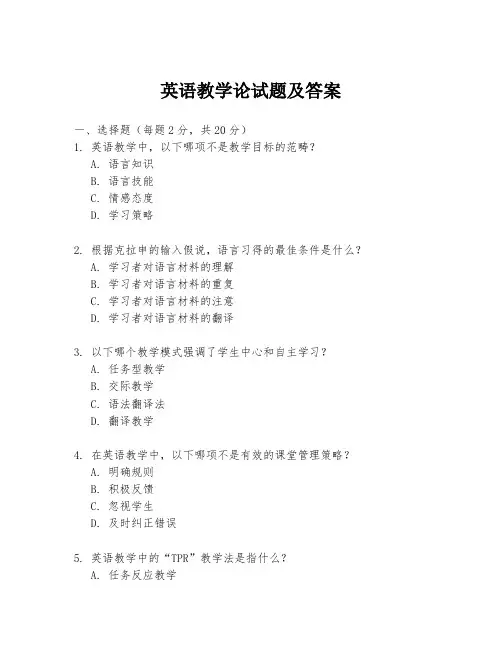
英语教学论试题及答案一、选择题(每题2分,共20分)1. 英语教学中,以下哪项不是教学目标的范畴?A. 语言知识B. 语言技能C. 情感态度D. 学习策略2. 根据克拉申的输入假说,语言习得的最佳条件是什么?A. 学习者对语言材料的理解B. 学习者对语言材料的重复C. 学习者对语言材料的注意D. 学习者对语言材料的翻译3. 以下哪个教学模式强调了学生中心和自主学习?A. 任务型教学B. 交际教学C. 语法翻译法D. 翻译教学4. 在英语教学中,以下哪项不是有效的课堂管理策略?A. 明确规则B. 积极反馈C. 忽视学生D. 及时纠正错误5. 英语教学中的“TPR”教学法是指什么?A. 任务反应教学B. 总过程反应教学C. 肢体反应教学D. 测试准备教学二、填空题(每空1分,共10分)6. 克拉申的________假说认为,语言输入应该是“可理解的”,即略高于学习者当前水平。
7. 英语教学中的“TBLT”是指________,这是一种以任务为中心的教学方法。
8. 教师在课堂上使用________可以提高学生的参与度,激发学生的学习兴趣。
9. 英语教学中,教师应该鼓励学生使用________来表达自己的观点和想法。
10. 教学评价的目的是________,以促进学生语言能力的发展。
三、简答题(每题10分,共20分)11. 简述英语教学中“以学生为中心”的教学理念。
12. 描述一下在英语教学中如何实施“形成性评价”。
四、论述题(每题15分,共30分)13. 论述英语教学中文化意识的重要性及其在教学中的应用。
14. 分析现代技术在英语教学中的应用,并讨论其对提高教学效果的影响。
五、案例分析题(20分)15. 阅读以下教学案例,分析教师的教学策略,并提出可能的改进建议。
案例描述:某英语教师在教授高中英语课程时,发现学生对英语语法的学习兴趣不高。
为了提高学生的学习兴趣,教师决定采用游戏化教学方法。
在课堂上,教师设计了一个语法游戏,让学生通过角色扮演和小组竞赛的方式,学习并应用英语语法规则。
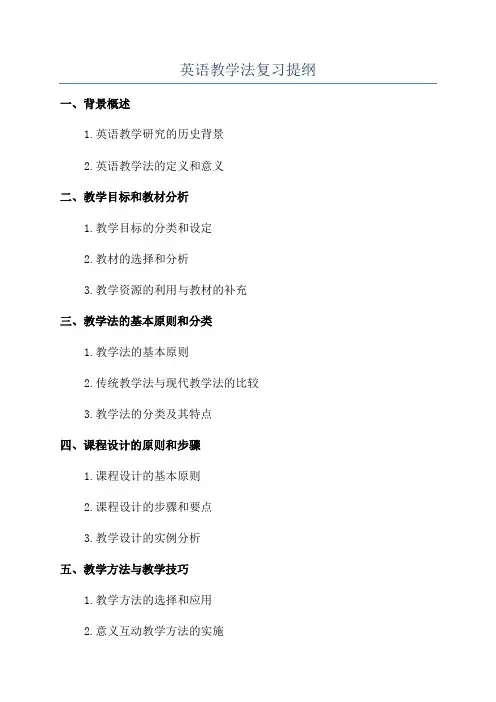
英语教学法复习提纲
一、背景概述
1.英语教学研究的历史背景
2.英语教学法的定义和意义
二、教学目标和教材分析
1.教学目标的分类和设定
2.教材的选择和分析
3.教学资源的利用与教材的补充
三、教学法的基本原则和分类
1.教学法的基本原则
2.传统教学法与现代教学法的比较
3.教学法的分类及其特点
四、课程设计的原则和步骤
1.课程设计的基本原则
2.课程设计的步骤和要点
3.教学设计的实例分析
五、教学方法与教学技巧
1.教学方法的选择和应用
2.意义互动教学方法的实施
3.教学技巧的训练与应用
六、评估与反馈
1.评估的概念和种类
2.教学评估的重要性和方法
3.反馈的意义和方法
七、多媒体技术在英语教学中的应用
1.多媒体技术的发展与应用
2.多媒体教学的优势和挑战
3.多媒体教学案例分析
八、教学评价和自我提升
1.教学评价的概念和目的
2.教师自我提升的途径和方法
3.教学反思和改进的实践
九、教学实践总结和启示
1.教学实践的经验总结
2.教学实践对教师职业发展的启示
3.未来英语教学的发展趋势
以上是针对英语教学法复习的提纲,可以根据自己的需要进行有针对性的复习和整理。
为了更好地掌握和应用英语教学法,建议在复习时结合实际案例和实践进行深入研究。
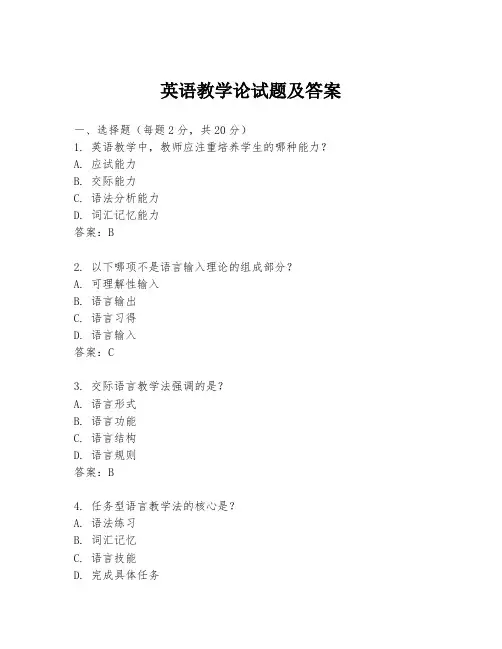
英语教学论试题及答案一、选择题(每题2分,共20分)1. 英语教学中,教师应注重培养学生的哪种能力?A. 应试能力B. 交际能力C. 语法分析能力D. 词汇记忆能力答案:B2. 以下哪项不是语言输入理论的组成部分?A. 可理解性输入B. 语言输出C. 语言习得D. 语言输入答案:C3. 交际语言教学法强调的是?A. 语言形式B. 语言功能C. 语言结构D. 语言规则答案:B4. 任务型语言教学法的核心是?A. 语法练习B. 词汇记忆C. 语言技能D. 完成具体任务答案:D5. 以下哪项不是英语教学中常用的教学方法?A. 直接法B. 翻译法C. 情景法D. 语法翻译法答案:D二、填空题(每题2分,共20分)1. 英语教学中,教师应通过______来激发学生的学习兴趣。
答案:多种教学活动2. 语言输入假说认为,语言习得需要______的输入。
答案:可理解性3. 交际语言教学法认为,语言教学的目的是让学生能够进行______。
答案:有效交际4. 任务型语言教学法强调通过______来学习语言。
答案:完成任务5. 英语教学中,教师应注重培养学生的______能力。
答案:自主学习能力三、简答题(每题10分,共30分)1. 简述任务型语言教学法的主要特点。
答案:任务型语言教学法的主要特点是将语言学习与实际使用结合起来,通过完成具体任务来促进语言知识的学习与应用。
2. 描述一下英语教学中如何有效地进行词汇教学。
答案:有效进行词汇教学的方法包括:使用上下文来教授词汇;通过多种活动让学生在实际语境中使用新词汇;鼓励学生使用词汇进行创造性写作或对话。
3. 论述英语教学中教师角色的变化。
答案:在英语教学中,教师的角色从传统的知识传授者转变为引导者、组织者和促进者,更多地鼓励学生自主学习,参与讨论和合作学习。
四、论述题(每题30分,共30分)1. 结合实际,论述英语教学中如何培养学生的跨文化交际能力。
答案:在英语教学中,培养学生的跨文化交际能力可以通过以下方式实现:首先,教师可以引入不同文化背景的阅读材料,让学生了解不同文化的特点;其次,通过角色扮演、模拟对话等活动,让学生在实际语境中练习跨文化交际;再次,鼓励学生参与国际交流项目,直接与不同文化背景的人交流;最后,教师应培养学生的批判性思维能力,帮助他们理解和尊重文化差异。
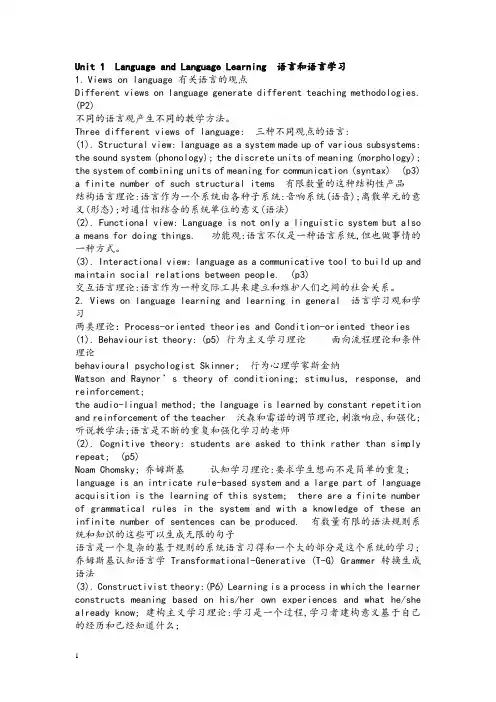
Unit 1 Language and Language Learning 语言和语言学习1.Views on language 有关语言的观点Different views on language generate different teaching methodologies. (P2)不同的语言观产生不同的教学方法。
Three different views of language: 三种不同观点的语言:(1). Structural view: language as a system made up of various subsystems: the sound system (phonology); the discrete units of meaning (morphology); the system of combining units of meaning for communication (syntax) (p3) a finite number of such structural items 有限数量的这种结构性产品结构语言理论:语言作为一个系统由各种子系统:音响系统(语音);离散单元的意义(形态);对通信相结合的系统单位的意义(语法)(2). Functional view: Language is not only a linguistic system but alsoa means for doing things. 功能观:语言不仅是一种语言系统,但也做事情的一种方式。
(3). Interactional view: language as a communicative tool to build up and maintain social relations between people. (p3)交互语言理论:语言作为一种交际工具来建立和维护人们之间的社会关系。
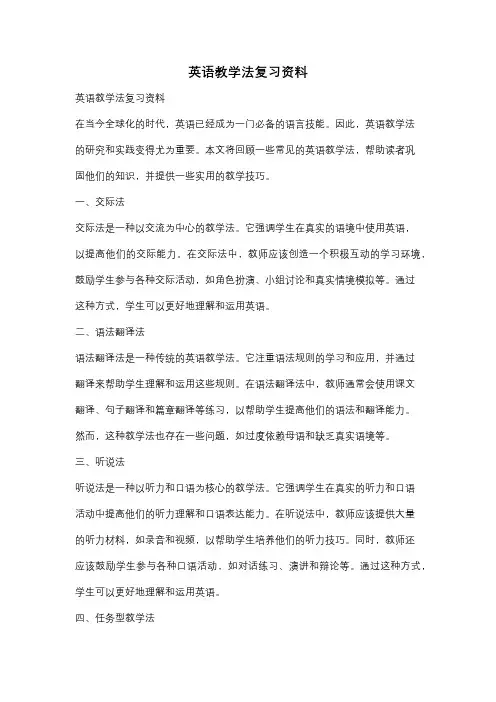
英语教学法复习资料英语教学法复习资料在当今全球化的时代,英语已经成为一门必备的语言技能。
因此,英语教学法的研究和实践变得尤为重要。
本文将回顾一些常见的英语教学法,帮助读者巩固他们的知识,并提供一些实用的教学技巧。
一、交际法交际法是一种以交流为中心的教学法。
它强调学生在真实的语境中使用英语,以提高他们的交际能力。
在交际法中,教师应该创造一个积极互动的学习环境,鼓励学生参与各种交际活动,如角色扮演、小组讨论和真实情境模拟等。
通过这种方式,学生可以更好地理解和运用英语。
二、语法翻译法语法翻译法是一种传统的英语教学法。
它注重语法规则的学习和应用,并通过翻译来帮助学生理解和运用这些规则。
在语法翻译法中,教师通常会使用课文翻译、句子翻译和篇章翻译等练习,以帮助学生提高他们的语法和翻译能力。
然而,这种教学法也存在一些问题,如过度依赖母语和缺乏真实语境等。
三、听说法听说法是一种以听力和口语为核心的教学法。
它强调学生在真实的听力和口语活动中提高他们的听力理解和口语表达能力。
在听说法中,教师应该提供大量的听力材料,如录音和视频,以帮助学生培养他们的听力技巧。
同时,教师还应该鼓励学生参与各种口语活动,如对话练习、演讲和辩论等。
通过这种方式,学生可以更好地理解和运用英语。
四、任务型教学法任务型教学法是一种以任务为导向的教学法。
它注重学生在解决实际问题的过程中学习和应用英语。
在任务型教学法中,教师应该设计一系列有挑战性的任务,以激发学生的学习兴趣和动机。
同时,教师还应该提供必要的语言支持和反馈,以帮助学生完成任务。
通过这种方式,学生可以更好地运用英语解决问题,并提高他们的学习效果。
五、多媒体教学法多媒体教学法是一种以多媒体技术为支持的教学法。
它通过使用电脑、投影仪和互联网等工具,提供丰富多样的学习资源,以帮助学生更好地理解和运用英语。
在多媒体教学法中,教师可以使用动画、音频和视频等多媒体材料,以增加学生的学习兴趣和参与度。
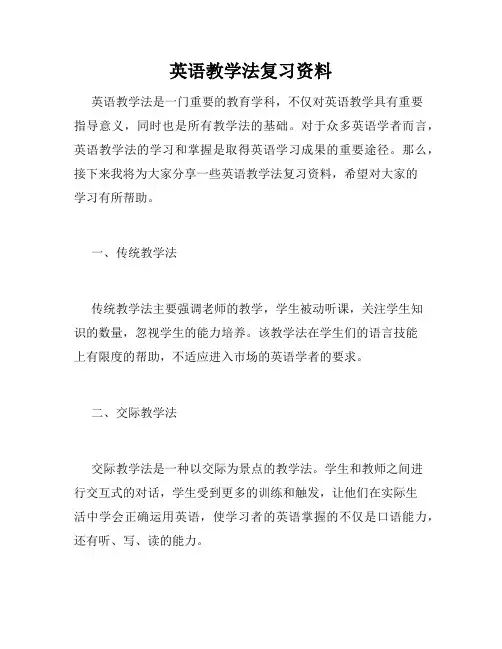
英语教学法复习资料英语教学法是一门重要的教育学科,不仅对英语教学具有重要指导意义,同时也是所有教学法的基础。
对于众多英语学者而言,英语教学法的学习和掌握是取得英语学习成果的重要途径。
那么,接下来我将为大家分享一些英语教学法复习资料,希望对大家的学习有所帮助。
一、传统教学法传统教学法主要强调老师的教学,学生被动听课,关注学生知识的数量,忽视学生的能力培养。
该教学法在学生们的语言技能上有限度的帮助,不适应进入市场的英语学者的要求。
二、交际教学法交际教学法是一种以交际为景点的教学法。
学生和教师之间进行交互式的对话,学生受到更多的训练和触发,让他们在实际生活中学会正确运用英语,使学习者的英语掌握的不仅是口语能力,还有听、写、读的能力。
三、任务教学法任务教学法强调学生要作出自己的决策,在老师的指导下进行任务。
这种教学法强调学生的技能和能力的发展,采用任务和生活场景,培养学生的英语运用能力。
四、建构主义教学法建构主义教学法主要强调学生从自己的角度去理解和掌握知识,让学习者主动地采取一定的观点和各种方法去理解和掌握知识。
学生采用的是他们自己的这些经验、观点和知识来处理和整理材料。
以上四点只是英语教学法中的一些例子,教学法的种类是无限的。
教师可以很好的结合各种教学法进行教学,以使学生的英语知识和学习方式更加全面和多样化。
总之,要成为一个出色的英语教师或者学者,我们需要了解和掌握多种教学法,以此融会贯通,结合自己的教学实践,创造出一种深入人心,适合学生需要的英语阅读、写作、听力、口语教学方案。
希望本文所分享的英语教学法复习资料能够帮助大家更好的学习和掌握英语教学法。
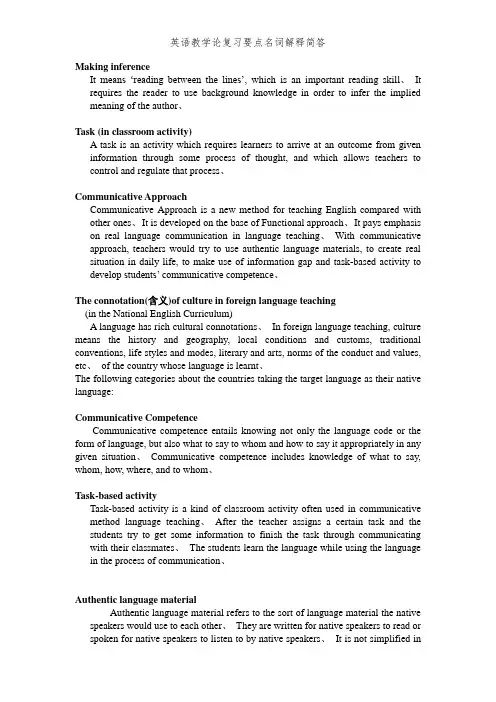
Making inferenceIt means ‘reading between the lines’, which is an important reading skill、It requires the reader to use background knowledge in order to infer the implied meaning of the author、Task (in classroom activity)A task is an activity which requires learners to arrive at an outcome from giveninformation through some process of thought, and which allows teachers to control and regulate that process、Communicative ApproachCommunicative Approach is a new method for teaching English compared with other ones、It is developed on the base of Functional approach、It pays emphasis on real language communication in language teaching、With communicative approach, teachers would try to use authentic language materials, to create real situation in daily life, to make use of information gap and task-based activity to develop students’ communicative competence、The connotation(含义)of culture in foreign language teaching(in the National English Curriculum)A language has rich cultural connotations、In foreign language teaching, culture means the history and geography, local conditions and customs, traditional conventions, life styles and modes, literary and arts, norms of the conduct and values, etc、of the country whose language is learnt、The following categories about the countries taking the target language as their native language:Communicative CompetenceCommunicative competence entails knowing not only the language code or the form of language, but also what to say to whom and how to say it appropriately in any given situation、Communicative competence includes knowledge of what to say, whom, how, where, and to whom、Task-based activityTask-based activity is a kind of classroom activity often used in communicative method language teaching、After the teacher assigns a certain task and the students try to get some information to finish the task through communicating with their classmates、The students learn the language while using the language in the process of communication、Authentic language materialAuthentic language material refers to the sort of language material the native speakers would use to each other、They are written for native speakers to read or spoken for native speakers to listen to by native speakers、It is not simplified inany way for the convenience of learners of the language、Such as English novels, poems, advertisements, films, speeches, programs on radio or TV, news reports, plays, etc、We advocate English teachers should use authentic language materials as teaching materials in English teaching、Communicative approachCommunicative approach is a new method for teaching English compared with other ones、It is developed on the base of Functional approach、It pays emphasis on real language communication in language teaching、With communicative approach, teachers would try to use authentic language materials, to create real situation in daily life, to make use of information gap and task-based activity to develop students’ communicative competence、Information gapReal communication is often initiated because of the existence of an information gap、The speaker has got the information which the listener does not know or the speaker wants to know information the listener has got、The gap of information between the two communicators is called information gap、The purpose for people to communicate with other people is to fill the information gap、It’s also an important concept in communicative approach, for information gap creates the need and the desire to have real communication、To apply information gap to language teaching in classroom will be effective to develop students’ language skills for communication、The five objectives in the new National English Curriculum are:1、) Language knowledge — phonetics; vocabulary; grammar; function and topic2)、Language skills — listening; speaking; reading and writing3)、Learning strategies —cognitive strategy; controlling strategy; communicativestrategy and resource strategy、4)、Culture awareness — cultural knowledge; cultural understanding; awareness andcompetence of cross-cultural communication5)、Affection and attitude — motivation and interest; self-confidence and strong will;spirit of cooperation; consciousness of motherland and international prospect The relationship among the five objectives and functions of each objective undertaking、Viewed from the perspective of language learning, language skills ensure the basic ability to learn the language, language knowledge forms the basis of comprehensive language, competenc e, students’ affect and attitude strongly influence their learning and development, successful learning strategies improve the effectiveness of students’learning, and cultural awaren ess ensures student’s appropriate use of the language、The five teaching steps of English classroom teaching are:Classroom arrangement: ----- to call the students’ attention to the class、Reviewing and checking: -----to review and check the contents learned before,and set up a bridge between the old knowledge and the new ones、Presentation: ----- to introduce the new materials in different ways、Practicing: ---- to practice and consolidate the new materials、a、Mechanical practice ---- form-focused practice (language structure)b、Meaningful practice ---- meaning-focused practice (language usage)c、Communicative practice ---- applying-focused practice (language application)Summing up and assignment: ----- to assign the students some homework to do after class、Formative assessmentSummative assessmentLanguage skillsLanguage knowledgeAffect and attitudeLearning strategiesCultural awarenessClassroom interactionReceptive classroom activityProductive classroom activityWarm-up activityClassroom instruction 61Procedural explanation 62Content explanation 62Open question 64Closed question 64Display question 64Referential question 64Procedural question 64Convergent question 65Divergent question 65Mistake 69Error 69Word stress 80Sentence stress 80Intonation 81Morpheme 107Inductive learning method 124Deductive learning method 124(Inductive approach)(Deductive approach)Denotative meaning 138Connotative meaning 139Collocation 140Active (productive) vocabulary 144Passive (receptive) vocabulary 144Language acquisition device 424, 454Authentic language material 参见上面的内容The abbreviations of some terms of ETM occurred in our text book、(omitted)。
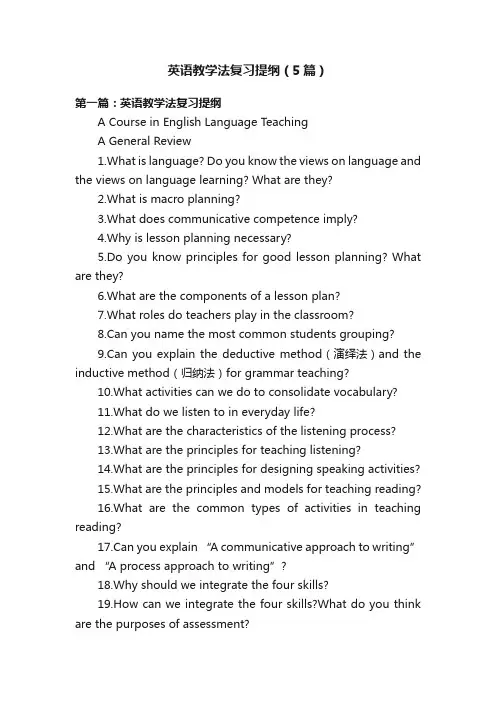
英语教学法复习提纲(5篇)第一篇:英语教学法复习提纲A Course in English Language TeachingA General Review1.What is language? Do you know the views on language and the views on language learning? What are they?2.What is macro planning?3.What does communicative competence imply?4.Why is lesson planning necessary?5.Do you know principles for good lesson planning? What are they?6.What are the components of a lesson plan?7.What roles do teachers play in the classroom?8.Can you name the most common students grouping?9.Can you explain the deductive method(演绎法)and the inductive method(归纳法)for grammar teaching?10.What activities can we do to consolidate vocabulary?11.What do we listen to in everyday life?12.What are the characteristics of the listening process?13.What are the principles for teaching listening?14.What are the principles for designing speaking activities?15.What are the principles and models for teaching reading?16.What are the common types of activities in teaching reading?17.Can you explain “A communicative approach to writing” and “A process approach to writing”?18.Why should we integrate the four skills?19.How can we integrate the four skills?What do you think are the purposes of assessment?第二篇:英语教学法复习提纲小学英语教学法复习提纲第一章1.小学生学习外语的特点:(1)模仿力强、记忆力好、勇于开口;(2)活泼好动,想像力丰富,富于创造力,喜欢新事物,乐于参加活动;(3)喜欢动身、动手、动脑做事情;(4)喜欢容易达到的学习目标;(5)精力集中时间比较短;(6)注意力较易分散,自我管理能力不强(7)理解复杂的语言指令还有一定的困难;(8)学习的目的性不如成人那样强,快乐时才会学习;(9).语言规则分析能力较差2.小学英语教学的主要任务:通过听、说、看、玩、唱等一系列的教学活动,对学生进行听说读写的基本训练,激发学生学习英语的兴趣和动机,培养良好的学习习惯,使学生获得一些英语的感性知识,打下较好的语音基础,学习一定量的词汇,接触一定量的日常交际用语,从而具有以听说能力为主的初步交际能力,同时在英语学习过程中受到良好的思想品德教育,个性得到健康和谐的发展。
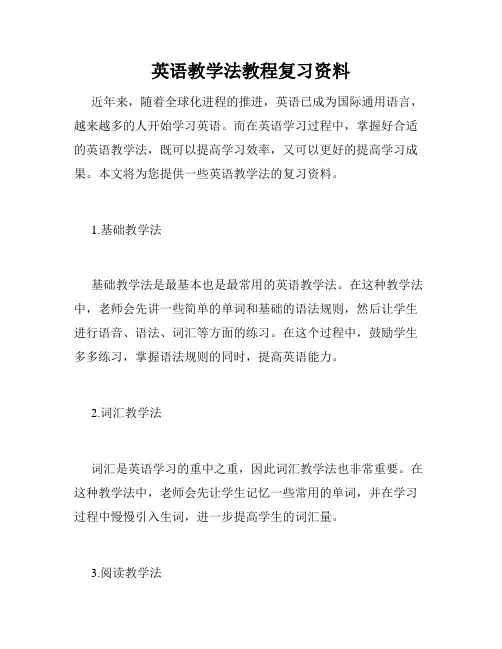
英语教学法教程复习资料近年来,随着全球化进程的推进,英语已成为国际通用语言,越来越多的人开始学习英语。
而在英语学习过程中,掌握好合适的英语教学法,既可以提高学习效率,又可以更好的提高学习成果。
本文将为您提供一些英语教学法的复习资料。
1.基础教学法基础教学法是最基本也是最常用的英语教学法。
在这种教学法中,老师会先讲一些简单的单词和基础的语法规则,然后让学生进行语音、语法、词汇等方面的练习。
在这个过程中,鼓励学生多多练习,掌握语法规则的同时,提高英语能力。
2.词汇教学法词汇是英语学习的重中之重,因此词汇教学法也非常重要。
在这种教学法中,老师会先让学生记忆一些常用的单词,并在学习过程中慢慢引入生词,进一步提高学生的词汇量。
3.阅读教学法阅读教学法是英语学习的重点之一,它不仅可以提高学生的阅读能力,也可以加深他们对语言的理解。
在这种教学法中,老师会让学生阅读一些有趣的文章,并且分析一些生词和语法规则,让学生从中学习。
4.听力教学法听力教学法对于掌握英语听力能力非常重要。
在这种教学法中,老师会播放一些英语听力材料,让学生进行听力练习。
同时,老师会讲解一些常用的英语词汇和语法规则,让学生更好地理解听力材料。
5.口语教学法口语教学法是英语教学中最具挑战性和难度的教学法。
在这种教学法中,老师会对学生进行口语练习,并给出一些针对性的建议和指导,让学生不断改进口语表达能力。
以上就是几种常见的英语教学法,当然这些教学法并非独立的存在,老师可以根据学生的实际情况,将以上教学法进行有机结合,构建适合学生的教学方案。
总之,英语教学法不仅是学生提升英语能力的重要工具,也是教师们提高英语授课质量的重要途径。
希望本文提供的英语教学法复习资料能对广大英语学习者和教师有所帮助。
英语教学法是研究如何有效地教授英语的学科。
它包括教学策略、教学方法、教学评估等方面的内容。
在英语学习过程中,教学法的运用非常关键。
在这篇文章中,我们将对英语教学法进行复习和总结,以便更好地教授英语。
一、课堂教学1.教师适时引导在课堂教学中,教师需要适时引导学生。
这就需要教师综合运用不同的教学方法,如讲解、演示、问答、小组讨论等,以激发学生的学习热情和积极性,并帮助学生理解和巩固所学知识。
2.活动丰富多样英语课堂教学应该活动丰富多样,可以利用角色扮演、情境模拟、游戏等方式来加强学生对英语语言的运用和理解。
3.鼓励学生合作在课堂上,教师应该鼓励学生合作,让学生感受到英语不仅是一种语言交流工具,更是一种交流思想、共同探索的工具。
二、口语训练1.创造轻松的语言环境在口语训练中,教师需要创造轻松、自然的语言环境,让学生感受到说英语的快乐,能够自然地表达自己的思想和观点。
2.鼓励语言交流在口语训练中,教师应该鼓励学生进行语言交流,不仅要追求语言表达的准确性和流畅性,也要注重交流和沟通的实际效果。
3.运用真实情境英语口语训练中,可以运用真实情境,如角色扮演、情境模拟、职场演讲等方式,帮助学生进行英语口语的实践训练和提高。
三、写作训练1.培养写作兴趣在写作训练中,教师应该培养学生的写作兴趣,通过让学生阅读好的英文文章,引导学生独立思考、表达和模仿,激发学生写作的热情。
2.学生自主探究在写作训练中,学生应该被鼓励自主探究写作的规律和技巧,根据学生的实际情况,为学生提供针对性的指导,让学生不断地反思、修改、完善自己的作品。
3.多样化的写作形式在写作训练中,教师应该引导学生学习和掌握不同的写作形式,如议论文、说明文、记叙文等,让学生通过写作巩固和提高英语语言能力。
四、词汇和语法训练1.学习基本语法知识在词汇和语法训练中,教师应该帮助学生学习基本的语法知识,如词性、时态等,让学生掌握正确的语言基础。
2.从具体的语境入手在词汇和语法训练中,教师应该从具体的语境入手,让学生在真实的语境中学习新的词汇和语法,帮助学生提高语言应用能力。
英语学科教学论考试题型说明本次考试侧重学生对语言教学理论和方法的理解及应用,而不是对理论知识的识记。
学生在复习时应力求理解教材中的重要语言教学理念和方法,并学会运用,不要死记硬背。
由于考试题目不涉及基本定义、概念的简单识记,考试时夹带小抄不起任何作用。
I. Choose the best answer (20%, 1’×20=20’)选择题绝大多数题目给学生提供语言教学活动实例或语言学习情境,让学生运用所学教学法理论知识对这些活动、情境进行分析、鉴别和判断。
II. True or false (20%, 1’×20=20’)语言教学基本理念、方法的命题判断。
III. Problem Solving (30%, 10’ ×3=30’)三小题(同去年题型)。
提供有问题的教学情境,要求学生简要回答问题所在并提供解决方案。
IV. Mini lesson planning (30%, 10’ ×3=30’)三小题。
提供教学材料,学生根据要求做简短教学设计。
如根据所提供的教学素材写出教学目标;根据所提供的教学素材设计一项读前活动等等。
两套试题基本涉及到各种语言技能(听说读写)教学和语言知识(词汇、语法)教学。
考试范围:一到十二章。
Unit 1 Language and Learning1. Views on language:1) Structural view on language:The structural view sees language as a linguistic system made up of various subsystems: from phonological, morphological, lexical, etc. to sentences. Each language has a finite number of such structural items. To learn a language means to learn these structural items so as to be able to understand and produce language.This view on language limits knowinga language to knowing its structural rules and vocabulary.2) Functional view on language:The functional view sees language as a linguistic system but also as a means for doing things. Learners learn a language in order to be able to do things with it. To perform functions, learners need to know how to combine the grammatical rules and the vocabulary to express notions that perform the functions. This view on language adds the need to know how to use the rules and vocabulary to do whatever it is one wants to do.3) Interactional view on language:The interactional view considers language as a communicative tool, whose main use is to build up and maintain social relations betweenpeople. Therefore, learners not only need to know the grammar and vocabulary of the language but as importantly they need to know the rules for using them in a whole range of communicative contexts. This view on language says that to know how to do what one wants to do involves also knowing whether it is appropriate to do so, and where, when and how it is appropriate to do it. In order to know this, the learner has to study the patterns and rules of language above the sentence level to learn how language is used in different speech contexts.2. Views on language learning1) Behaviourist theory:The behaviorist theory of language learning was initiated by behavioral psychologist Skinner, who applied Watson and Raynor‟s theory of conditioning to the way humans acquire language (Harmer, 1983) The key point of the theory of conditioning is that “you can train an animal to do anything if you follow a certain procedure which has three major stages, stimulus, response, and reinforcement”(Harmer1983: 30) Based on the theory of conditioning, Skinner suggested language is also a form of behavior. It can be learned the same way as an animal is trained to respond to stimuli. This theory of learning is referred to as behaviorism.2) Cognitive theory:The term cognitivism is often used loosely to describe methods inwhich students are asked to think rather than simply repeat. It seems to be largel y the result of Noam Chomsky‟s reaction to Skinner‟s behaviorist theory, which led to the revival of structural linguistics. According to Chomsky, language is not a form of behavior, it is an intricate rule-based system and a large part of language acquisition is the learning of this system. There are a finite number of grammatical rules in the system and with knowledge of these rules an infinite of sentences can be produced. A language learner acquires language competence, which enables him to produce language.3. Learning theories in general1) Constructivist theory:The constructivist theory believes that learning is a process in which the learner constructs meaning based on his/her own experiences and what he/she already knows. It is believed that education is used to develop the mind, not just to rote recall what is learned. Teaching should be built based on what learners have already known and engage learners in learning activities. Teachers need to design environments and interact with learners.2) Socio-constructivist theory:The socio-constructivist theory represented by Vygotsky (1978) emphasizes interaction and engagement with the target language in a social context based on the concept of …Zone of Proximal Development‟(ZPD) and scaffolding. Learning is best achieved through the dynamic interaction between the teacher and the learner and between learners.4. What is a good language teacher?1) The main elements of a good English teacher are ethic devotion, professional qualities, and personal styles.(Then try to explain these three elements respectively according to your own understanding)2) Teachers‟ professional development model by Wallace (PP9-10)Unit 2 Communicative Principles and Task-based Language Teaching 1. The differences between language use in real life and thetraditional language teaching (P15)2. The goal of communicative language teaching (P16)3. Communicative Competence1) Linguistic competence:Linguistic competence is a term which is first mentioned by Noam Chomsky. It is understood as the tacit knowledge of language structure and the ability to use this knowledge to understand and produce language. For Chomsky, competence simply means knowledge of the language system: grammatical knowledge in other words.2) Communicative competence:Hedge (2000: 46-55) discusses five main components ofcommunicative competence: linguistic competence, pragmaticcompetence, discourse competence, strategic competence, andfluency. (PP17-19)Communicative competence entails knowing not only the language code or the form of language, but also what to say to whom and how to say it appropriately in any given situation. Communicative competence includes knowledge of what to say, when, how, where, and to whom.4. Three principles of communicative language teaching (P20)a) the communicative principle: Activities that involve realcommunication promote learning.b) the task principle: Activities in which language is used forcarrying out meaningful tasks promote learning (Johnson1982).c) the meaningfulness principle: Language that is meaningful to thelearner supports the learning process.4. Communicative activities:A sequence of activities represented in Littlewood (1981: 86):Pre-communicative activities: structural activities and quasi-communicative activitiesCommunicative activities: functional communication activities andsocial interaction activities(PP22-23, PP162-172)5. Six criteria for evaluating communicative classroom activities (PP24)6. Task-based Language Teaching (TBLT)1) Definitions of a task (PP27-28)2) Four components of a task (P28)3) The differences between tasks and exercises (PP28-30)Unit 3 The National English Curriculum1.Designing principles for the National English Curriculum (PP41-43,P310-311 Answers to Task 1)2.Goals and objectives of English language teaching (PP43-45, P312Answers to Task 3)3.Challenges facing English language teachers (PP48-49)Unit 4 Lesson Planning1. Lesson PlanningIt means making decisions in advance about what techniques, activities and materials will be used in the class.2. In what ways do the teachers benefit from the teaching plan? (P52-53)3. Principles for good lesson planning (PP53-54)4. Macro planning vs. micro planning (PP54-55)5. Components of a lesson plan (PP55-60)6. The three P’s model (P 59)Presentation: the teacher introduces the new language items to be learnt. The teacher focuses the students‟ attention on modelsentences, dialogues or other types of texts and checks theirunderstanding of the new language items.Practice:students are given the opportunities to use the newly presented language items in a controlled framework. This maydone by drills, or by repeating parts of the dialogue presentedin the presentation. This stage is intended to develop accuracyskills.Production:students give free and extensive expressions by integrating the new language items with the old throughactivities, aimed at developing fluency skills.7. The three-stage model (PP59-60):Pre-While-Post-Unit 5 Classroom Management1. Classroom management (P67)Classroom management involves teacher recognizing options, making decisions and putting them into actions.2. Teacher roles (PP68-72)3. Classroom instructions (PP73-74)4. Student grouping (PP74-77)1) whole class work (lockstep) 2) pair work3) group work 4) individual study5. Questioning in the classroom1) Classification of question types (PP83-84)2) Tips for making questioning more effective (PP85-86)6. Dealing with errors1) When to correct (P87)2) How to correct (PP87-88)Unit 6 Teaching Pronunciation1. The goal of teaching pronunciation (PP92-93)The goal of teaching pronunciation is not to teach learners to achieve a perfect imitation of a native accent, but simply to get the learners to pronounce accurately enough to be easily and comfortably comprehensible to other speakers.Our realistic goals of teaching pronunciation:ConsistencyIntelligibilitycommunicative efficiency2. Critical period hypothesis (PP92-93)3. Aspects of pronunciationUnit 7 Teaching Grammar1. The role of grammar in language learning (PP102-104)2. Grammar presentation methods:(PP104-106)Deductive method: the teacher presents the rule of the structure on the blackboard and explains it to the students. This would befollowed by the teacher giving several examples and then askingthe students to apply the rules themselves in some exercises.Inductive method: The teacher does not explain the rule at the beginning, but presents various language forms and the studentsare left to discover or induce the rules or generalizations on theirown.The guided discovery method3. Grammar practiceMechanical practice involves activities that are aimed at form accuracy. By doing mechanical practice, the students payrepeated attention to a key element in a structure. Substitutionand transformation drills are most frequently used in mechanicalpractice.Meaningful practice the focus is on the production, comprehension or exchange of meaning though the students “keep an eye on”the way newly learned structures are used in process. Meaningfulpractice usually comes after mechanical practice.4. Further suggestions about teaching grammar:1) Teach only those rules which are simple and which do not have too many exceptions.2) Do not spend too much time on grammar points, which do notappear to be very useful or important. Just make the studentsaware of the special features.3) Wherever possible, teach grammar in context.4) When presenting grammar, try to use charts, tables, diagrams,maps, drawings and realia to aid understanding.5) Avoid difficult grammatical terminology as much as possible.6) Allow enough opportunities for practice.7) Do not be frustrated by the student s‟ mistakes and errors, whichare inevitable in language learning.Unit 8 Teaching Vocabulary1. Understanding vocabulary and vocabulary learning (P116-118)Task 22. What does knowing a word mean? (PP118-124)3. Ways of presenting vocabulary (PP124-126)3. Consolidating vocabulary (PP126-129)Unit 9 Teaching Listening1. Characteristics of the listening process: (P139)Spontaneity, context, visual clues, listener‟s response, speaker‟s adjustment2. Models of listening1) Schema theory:The term schema was first used by the psychologist Bartlett (1932), and has had an important influence in the areas of speechprocessing and language comprehension.Bartlett argued that the knowledge we carry around in our heads is organized into interrelated patterns.Schema theory is based on the notion that past experiences lead to the creation of mental frameworks that help us make sense of newexperiences.2) Bottom-up model and top-down model (PP143-144)3. Major Listening Skillsi. Listening for gist: to get a general idea of what one hearsii. Listening for specific information: to pick out from the whole text what one regards as important or relevant, to concentrate only on the information one needsiii. Listening for detailed information: to obtain a detailed knowledge of a topiciv. Inferring: to “listen between the lines” (listen for what is not directly stated, to decode what is indirectly expressed, including the relationships between speakers, the moods or attitudes of the speakers, the physical setting of the text, and so on)Sources: a) intonation, b) the speaker‟s choice of words, c) the speaker‟s facial expressions, gestures or body movements v. Note-taking (to combine listening and writing)4. Principles for teaching listening (PP139-140):F o c u s o n p r o c e s s r a t h e r t h a n o n t h e r e s u l tC o m b i n e l i s t e n i n g w i t h o t h e r s k i l l sF o c u s o n t h e c o m p r e h e n s i o n o f m e a n i n gG r a d e d i f f i c u l t y l e v e l a p p r o p r i a t e l y5. Three stages for teaching listening:Pre-listening stage (PP144-146)While-listening stage (PP146-151)Post-listening stage (PP152-154)Unit 10 Teaching Speaking1. What are the characteristics of spoken language?a. in fairly simple sentence structuresb. in incomplete sentencesc. in informal, simple or common vocabularyd. with broken grammar, false starts, hesitation, fillers, etc.e. with a high proportion of repetition or redundancyf. largely unplanned organizationg. a low density of informationh. context dependent (Background knowledge is necessary tounderstand exactly what is being expressed.)2. Principles for designing a successful speaking activity (PP161-162)Maximum foreign talkEven participationHigh motivationRight language level3. Types of speaking tasks (PP162-172)Unit 11 Teaching Reading1. The nature of reading (PP175-176 Task 2)2. What are effective readers?1)Have a clear purpose in reading2)Read silently.3)Read phrase by phrase, rather than word by word4)Concentrate on the important bits, skim the rest, and skip theinsignificant parts5)Use different speeds and strategies for different reading tasks6)Perceive the information in the target language rather than mentallytranslate7)Guess the meaning of new words from the context, or ignore them8)Use background information to help understand the text3. Three models for teaching reading: (PP184-185)Bottom-up approach: The reader builds up the meaning of a text on the basis of decoding smaller units: first words, and phrases, then sentences and paragraphs, and finally working out the meaning of the whole text.Top-down approach:The reader uses his or her knowledge of the topic or of the type of the text and makes predictions about what the text will contain, then he uses these predictions to check his understanding of the text. In this way, the reader gets a global view of the text before he dives into the details of it.Interactive approach: The reader uses the above two approachestogether, and the two ways interact with each other in the understanding of the text. That means the reader might predict the context of the text by using his knowledge of the topic (top-down), then look for key words (bottom-up) to check the prediction, or get the main gist of the text by skimming it quickly (top-down) and examine the writer‟s choice of vocabulary for understanding the implied meaning.4. Major reading strategies:Skimming: the reader moves his eyes over the text very quickly justin order to get the main idea of the text, or sometimes decidewhether it is worth reading more deeply or not.Scanning: the reader locates a particular piece of information without necessarily understanding the rest of a text or passage. For example, the reader may read through a chapter of a book as rapidly aspossible in order to find out information about a particular date,such as when someone was born.Inferring: reading between the lines. Make use of syntactic, logicaland cultural clues to discover the meaning of unknown elements.Such as the writer‟s opinions and attitudes which are not directl ystated in the text.5. Principles for teaching reading:a) The selected texts and attached tasks should be accessible to the students.b) Tasks should be clearly given in advance.c) Tasks should be designed to encourage selective and intelligentreading for the main meaning rather than test the students‟understanding of trivial details.d) Tasks should help develop student s‟ reading skills rather than testtheir reading comprehension;e) Teachers should help the students not merely to cope with oneparticular text in front of them but with their reading strategiesand reading ability in general.f) Teachers should help the students to read on their own.7. Three stages for teaching reading:Pre-reading stage (PP185-193)While-reading stage (PP194-201)Post-reading stage (PP201-204)8. Information transfer activities (PP194-198)Unit 12 Teaching Writing1. The differences between “writing for language learning”and“writing for communication”(PP208-211)2. Problems in writing tasks (P212)a) They are mainly accuracy-based.b) They are designed to practise certain target structures.c) There is insufficient preparation before the writing stage.d) There is no sense of audiencee) There is no sense of authenticity.f)There is no opportunity for creative writing, particularly forexpressing unusual or original ideas.2. Two different approaches to teaching writing:Product approach;(P208, 213)In the traditional ELT classroom, writing often goes this way: the teacher gives a topic or a selection of topics, a set ofrequirements, and a time limit. The students finish the taskwithin the time limit and hand in the final product. Thestudents‟ work is evaluated based on the accuracy of the finalproduct. The process which the students go through whiledoing the writing task is virtually ignored.Process approach (PP213-219)The 'process approach' is defined as 'an approach to the teaching of writing which stresses the creativity of the individual writer,and which pays attention to the development of good writingpractices rather than the imitation of models'. Thus, the focusshifts from the final product itself to the different stages thewriter goes through in order to create this product. by breakingdown the task as a whole into its constituent parts.3. Features of process writing (P214)4. Writing Processes (PP213-219)。
英语教学论复习---------------------------------------英语教学论复习一、填空1. 国外外语教学理念中有影响的主要是西方的外语教学理念,按其兴盛时期顺序大致包括:语法-翻译法、直接法、情景法、听说法、人本主义的教学法、交际教学。
2. 我们要理解教育,就必须把握教育的两个基本要素:引导与发展。
3. 中小学英语教学中的要素包括学生、教师、教学内容和教学环境等。
4. 在新课程理念指导下的教师被赋予新的角色,教师不仅仅是知识的传授者、课堂的控制者,还应该成为学生行为的评价者、活动的组织者、活动的促进者、活动的参与者、资源提供者、研究者、激励者等。
教师的角色是多重的,相互转换的。
5. 我国学者对英语教师基本素质的构成虽各持不同观点,但归纳起来主要包括以下三方面:教师的师德素质、教师的人格素质和教师的专业素质。
6. 教学有着内在的规定性,教学原则就是一种规定性的教学规范。
中小学英语教学中的基本原则包括学生中心原则、合理目标原则、有效原则、真实性原则这四项。
7. 在课堂上,教师给予学生的活动指令应该遵循几个原则,包括清晰原则、演示原则、检查原则、时机原则、先行组织原则、指令完备原则、起止清楚原则。
8. 教学资源指在教学的准备和实施过程中所能运用到的各种资源,其中包括文本资源、电子资源、人力资源等。
9. 教学设计一般包括:学习需求分析、学习内容分析、学习者分析、教学策略设计、教学过程设计、教学技术设计、评价目标确定与方法选择、形成性评价设计和总结性评价设计等内容,可以分为:分析—设计—评价—反馈四个环节,每个环节有着不同的要素。
10. 任务型课堂教学一般分为三个部分,即任务前、任务中和任务后阶段。
11. 教学过程作为教学活动具有知识传授功能、能力培养功能和素养发展功能,这三种功能在具体的教学过程中则是交叉循环出现,相互不可割裂的。
12. 中小学英语课堂教学活动大致分为教学启动、语言学习、语言运用实践、总结与结束四个类型。
在该教学法的语言理解阶段,教师提供易于使学生发现规则的语言材料,学生要理解教师讲授或提供的材料,发现和总结语法规则。
A。
直接法B.听说法C。
认知法D。
交际法答案:C在该教学法的课堂中,为要找出学生学习外语的难点(trouble spots),教师可以把母语和外语两个系统进行对比分析。
按照对比分析,两者的不同点将构成学习上的难点。
A。
直接法B.听说法C.认知法D。
交际法答案:B根据Canale 和Swain的交际能力理论,如果一个人具有社会语言能力,那么他那就___。
A。
能建立良好的社会关系B.具有较高的社会交际能力C。
能根据他所处的社会环境和语言的交际功,恰当地选择语言形式D.知道哪些话语是可行的,哪些话语是不可行的答案:C在该教学法的课堂里,一般来说,教师是命令的发出者,学生则是对命令作出反应的人或者是命令的发出者。
A。
听说法B.认知法C。
交际法D.全身反应法答案:D在该教学方法中,在学习语言过程中,教师是语言分析的引导者和语言项目操练的组织者。
A。
认知法B。
交际法C。
全身反应法D.任务型语言教学模式答案:D根据Canale 和Swain的交际能力理论,如果一个人知道如何开始对话、如何转换话题、如何结束对话,那么我们可以认为这个人具备了___。
A。
语法能力B。
社会语言能力C.语篇能力D.策略能力答案:D在该教学方法的课堂中,声音、简单句子会与教室、家庭、街道等不同环境中的实物和人物等联系进行教学.A.语法翻译法B.直接法C。
情景法D。
听说法答案:B该教学方法是在十九世纪末作为语法翻译法的批判而创立的外语教学的一种方法.它的特点包括:1)只使用目标语进行教学;2)意义通过语言、动作、物体等手段结合情景表达;3)先教说,然后教读、写;4)用归纳法讲授语法。
A。
语法翻译法B。
直接法C.情景法D。
听说法答案:B对比分析学者拉多认为,在外语学习中,当外语的结构和母语的结构___时,学习困难和错误就会出现。
英语学科教育学复习资料英语学科教育学复习资料英语学科教育学是培养英语教师的重要学科之一,它涉及到教育学的理论与实践在英语教学中的应用。
在学习英语学科教育学时,我们需要掌握一些复习资料,以便更好地理解和应用这门学科的知识。
本文将为大家介绍一些英语学科教育学的复习资料,帮助大家更好地备考。
一、教育学基础知识在学习英语学科教育学之前,我们需要先掌握一些教育学的基础知识。
这些知识包括教育学的定义、教育学的发展历程、教育学的主要理论流派等。
我们可以通过阅读教育学教材或参考书籍来学习这些基础知识。
此外,还可以通过参加教育学相关的讲座、研讨会等活动来深入了解教育学的最新研究动态。
二、英语教学理论英语学科教育学的核心内容是英语教学理论。
在学习英语教学理论时,我们需要掌握一些重要的理论框架和概念,如语言习得理论、教学法、评估与测试等。
我们可以通过阅读相关教材和学术论文来学习这些理论知识。
此外,还可以通过观摩优秀教师的课堂教学来了解这些理论在实际教学中的应用。
三、教材与教学设计在英语学科教育学中,教材与教学设计是非常重要的内容。
我们需要了解教材的编写原则、教材的评价标准以及如何根据学生的需求和能力设计有效的教学活动。
我们可以通过阅读教材编写的相关书籍和教材评价的研究论文来学习这些知识。
此外,还可以通过参加教材编写和教学设计的培训课程来提高自己的能力。
四、教育技术与多媒体教学随着科技的发展,教育技术在英语教学中的应用越来越重要。
我们需要了解教育技术的发展趋势、教育技术的应用原则以及如何使用多媒体教学工具来提高教学效果。
我们可以通过阅读教育技术的相关书籍和学术论文来学习这些知识。
此外,还可以通过参加教育技术培训课程和实践活动来提高自己的教育技术能力。
五、教育研究方法在英语学科教育学中,教育研究方法是非常重要的。
我们需要了解教育研究的基本原理、常用的研究方法以及如何设计和实施教育研究。
我们可以通过阅读教育研究方法的相关书籍和学术论文来学习这些知识。
824英语教学论824英语教学论是研究生入学考试中一门重要的科目,主要考察学生对英语教学理论和实践的理解和掌握程度。
以下是一些关于824英语教学论的复习建议:1.了解考试大纲:在开始复习前,建议考生先仔细阅读考试大纲,了解考试形式、考试内容、考试要求等,以便更好地制定复习计划。
2.系统复习英语教学法:英语教学法是824英语教学论的重要组成部分,考生需要系统复习英语教学法的基本概念、理论和实践,掌握各种教学法的优缺点和应用场景。
3.关注语言习得理论:语言习得理论是英语教学论的基础,考生需要深入理解语言习得的过程、影响因素和习得规律,为教学实践提供理论支持。
4.掌握教学评估方法:教学评估是英语教学过程中的重要环节,考生需要掌握各种教学评估的方法和技巧,包括学生评估、教师评估和课程评估等。
5.熟悉教材和教辅:教材和教辅是复习的重要资料,考生需要选择合适的教材和教辅,系统学习相关知识和理论,并配合练习题和模拟试题进行巩固和提高。
6.注重实践和应用:824英语教学论是一门实践性很强的科目,考生需要注重实践和应用,通过观察、分析和反思教学实践中的问题,提高自己的教学水平和解决问题的能力。
7.制定复习计划:制定合理的复习计划可以帮助考生更好地安排时间,明确每天的学习任务和目标。
建议考生根据自身情况制定个性化的复习计划,注重基础知识的掌握和实践能力的提升。
8.多做模拟试题:模拟试题可以帮助考生了解考试形式和难度,检验自己的复习效果和应试能力。
建议考生多做模拟试题,及时发现自己的不足之处并加以改进。
9.保持积极心态:824英语教学论是一门有一定难度的科目,考生需要保持积极的心态和良好的状态,遇到困难时及时调整心态,保持信心和耐心。
英语教学论复习一、填空1. 国外外语教学理念中有影响的主要是西方的外语教学理念,按其兴盛时期顺序大致包括:语法-翻译法、直接法、情景法、听说法、人本主义的教学法、交际教学。
2. 我们要理解教育,就必须把握教育的两个基本要素:引导与发展。
3. 中小学英语教学中的要素包括学生、教师、教学内容和教学环境等。
4. 在新课程理念指导下的教师被赋予新的角色,教师不仅仅是知识的传授者、课堂的控制者,还应该成为学生行为的评价者、活动的组织者、活动的促进者、活动的参与者、资源提供者、研究者、激励者等。
教师的角色是多重的,相互转换的。
5. 我国学者对英语教师基本素质的构成虽各持不同观点,但归纳起来主要包括以下三方面:教师的师德素质、教师的人格素质和教师的专业素质。
6. 教学有着内在的规定性,教学原则就是一种规定性的教学规范。
中小学英语教学中的基本原则包括学生中心原则、合理目标原则、有效原则、真实性原则这四项。
7. 在课堂上,教师给予学生的活动指令应该遵循几个原则,包括清晰原则、演示原则、检查原则、时机原则、先行组织原则、指令完备原则、起止清楚原则。
8. 教学资源指在教学的准备和实施过程中所能运用到的各种资源,其中包括文本资源、电子资源、人力资源等。
9. 教学设计一般包括:学习需求分析、学习内容分析、学习者分析、教学策略设计、教学过程设计、教学技术设计、评价目标确定与方法选择、形成性评价设计和总结性评价设计等内容,可以分为:分析—设计—评价—反馈四个环节,每个环节有着不同的要素。
10. 任务型课堂教学一般分为三个部分,即任务前、任务中和任务后阶段。
11. 教学过程作为教学活动具有知识传授功能、能力培养功能和素养发展功能,这三种功能在具体的教学过程中则是交叉循环出现,相互不可割裂的。
12. 中小学英语课堂教学活动大致分为教学启动、语言学习、语言运用实践、总结与结束四个类型。
13. 语音教学应遵循准确性、长期性、综合性、针对性、趣味性和交际性原则。
14.听力理解主要包括四个要素:接受、注意、理解意义和记忆。
15. 阅读理解分为四个层次:字面理解(仅仅理解文章的字面意义)、推断性理解(根据文章的结构,分析作者的观点,并运用自己已知知识,推断作者字里行间的隐含意义)、评估性理解(借助自身知识和自身评估原则对文章进行分析和评估)和欣赏性理解(根据自己的思想、情感及爱好等,领会文章的主题或写作技巧)。
16. 根据阅读理解模式理论,阅读教学的模式可分为以下三种:“自下而上”的模式(the bottom-up approach)、“自上而下”的模式(the top-down approach)和交互阅读教学模式(the interactive-compensatory approach)。
17. 黑板和粉笔是课堂教学中最常用、最普遍的一种教学媒体。
18. 教学资源的基本要素是:学生、学习内容、学习目标。
19. 大体来说,按照研究内容,校本教研可以分为校本课程研究、校本教学研究、校本学习研究和校本教师发展研究等。
20. 实验设计与数据收集是教学实验中最重要的两部分内容。
二、名词解释1. 教学教学是在有计划的系统性的过程中,依据一定的内容,按照一定的目的,借助一定的方法和技术,教师引导学生认识世界、学习和掌握知识与技能,同时得到全面发展的活动。
2. 教学设计教学设计是一种基于现代学习理论的现代教育技术,是教师基于学习者特征等学习需求分析,设计教学目标、教学过程、教学策略、教学技术,并进行评价反馈,以进行教学准备的过程。
教学设计技术与工具也可用于对于课堂教学进行过程性、质量性分析。
3. 中小学英语的教学原则中小学英语的教学原则是指在中小学英语知识传授、技能训练、运用能力培养、跨文化教育等教学活动中应遵循的基本规范与准则。
4. 课堂管理的定义课堂管理指教师为了使课堂教学能够更有效地进行,对上课时各学生的行为和活动加以组织和控制。
课堂管理包括把学生根据不同的课堂活动分组,使用教案,利用设备、教具等,指示和管理学生的行为和活动。
2.形成性评价形成性评价指在教学过程中为了获得有关学习的反馈信息,对学生所学知识的掌握程度所进行的系统性评价,是日常教学过程中由学生和教师共同参与的评价活动,其目的是对学生的学习行为、学习结果以及学习过程中的情感、态度、策略等方面的发展进行评价。
3.总结性评价总结性评价(也称终结性评价)是在一个学习阶段结束时对学生学习结果的评价,如期末考试、毕业学业考试等。
是检测学生综合语言运用能力发展程度的重要手段。
英语教学设计的总结性评价应依据课程标准的要求开展评价,着重考查学生在具体情境中运用英语的能力。
4. 学习策略的内涵学习策略(learning strategy),顾名思义,就是关于学习的策略,是旨在从认知角度、元认知角度、情感角度和社交角度对学习直接或间接发生作用的微观方法系统。
5. 文化教学的定义外语学科的文化教学是指在外语教学中将语言教学与所学语言国的国情、文化知识及语言所包含的文化背景知识融为一体的教学形式与方法。
6. 情感态度教学的定义情感态度教学,是指教师在教学过程中,在充分考虑认知因素的同时,运用一定的教学手段,通过激发、调动和满足学生的情感需要,以完善教学目标,增强教学效果的教学。
7. 教育技术教育技术是指通过创设、使用与管理适切的与技术相关的过程和资源来促进学,提升绩效的研究与伦理实践。
8. 课堂教学评价指课堂活动的组织、管理、评价以及与此有关的各种因素,是对课堂教学效果以及构成课堂教学过程各要素的分析与评价,是完整教学不可分割的一个组成部分,对促进课堂教学质量,推动教师发展有着不可替代的作用。
9. 教学反思中常用的方法包括教学日志、教学报告、调查与问卷、课程教学现场录音录像、听课和教学行为研究。
10. 反思教学反思教学是“教学及师资培训的一种方法,即教师通过批评性地反思他们的教学体会可以提高他们对教学的领悟能力和自身的教学质量,旨在培养教师对教学过程进行有创见、有分析和客观性的思考的能力,以作为改进课堂实践的。
11. 校本教研(school-based educational research)是一种以个体学校中发生的教育教学现象和事件为研究对象的应用性研究,重在解决实际问题。
12. 翻译教学法:又称语法翻译教学法,是一种以语法、词汇为主,通过阅读材料进行译入、译出练习,并借以培养学生阅读文学作品能力的教学方法。
13. 发展性教育观:是指一切为了学生发展的教育,学生的发展表现在全面发展和个性发展。
14. 合作学习:是指以小组合作方式从事学习活动的学习方式,强调学习过程中的协作与监控。
三、简答1. 我国中小学英语教育的总体目标应是什么?我国中小学英语教育的总体目标应是:通过英语语言知识、语言技能和文化知识教育,培养学生运用英语进行交际和自我表达的基本能力,并促使学生形成开放、合理的跨文化意识与相关情感态度价值观,同时促进学生思维能力、创新精神、终身学习能力等综合素养的发展。
2.请你谈一谈新课程标准实施以后,中小学英语教师的角色有哪些转变?新课程标准实施后,教师的角色也发生过了转变。
教师不仅是传统教学中知识的传授者,课堂教学的主宰者;他们被赋予的新的角色,他们还应该成为学生学习的引路人,行为的评价者,活动的组织者,内容的提示者、活动的参与者、资源提供者、研究者、激励者和引导者等。
教师的角色是多重的,相互转换的。
3.你认为高效率的英语教师的教学行为应该具有哪些特质?(1)教学目标明确。
(2)熟悉教学内容和策略。
(3)使学生明白寄予他们的期望以及原因。
(4)恰当运用现有的教学材料,以提供给学生更多的实践机会,使之深刻理解教学内容。
(5)了解学生,满足学生需要,预见他们知识中可能存在的误解。
(6)教给学生“元认知策略”,并创设情境让学生掌握。
(7)提出高低不同的认知目标,给予经常地适当的反馈以检测学生的理解水平。
(8)使自己的教学与其他学科交融为一体。
(9)对学生的成绩负责。
(10)反思自己的实践。
4. 结合《英语新课程标准》谈谈如何实施学生中心原则?实施学生中心原则要做到:(1)制定合理的教学方案;(2)在教学过程中体现以学生为中心理念;(3)充分分析和利用教材;(4)设置丰富多样的教学活动。
5. 怎样的课堂活动最有效?有效的教学活动,首先应该是基于学生的活动。
根据学生学习目标、现有水平、学习兴趣、学习机制等等,设计教学活动,是保证活动有效的第一步。
有效的教学活动应该充分基于教学内容,设计合理的教学过程。
学习是在教学过程中发生的,合理地安排讲授、训练、运用等环节,决定着活动的有效性。
有效的教学活动应该有着合理的评价目标。
评价,尤其是考试,必然影响着学生的学习过程中的目标确定与活动选择,我们只有把评价目标确定在能力上,学生就可以按照能力目标进行学习,从而达到学习目标,形成有效的学习。
有效的教学活动还要有针对不同学生的可选择的丰富的学习资源,因为英语学习很难在有限的课堂时间实现学习目标,学习资源对学习的有效性就非常重要。
6. 提问中应避免的问题鲍里奇(2002:237)提出了一些提问过程中应避免的问题,同样适用于英语课堂:●不要提出可能有多种答案的复杂的或模棱两可的问题。
●要准备接受正确的然而是异常的答案,特别是提出开放问题时。
●事先应该想好你为什么问这个问题,明白问题所要求的行为复杂性的程度。
●不要在还没有做出探寻之前就自己给自己的问题做出回答。
不要阻止学生把问题说完,就算是错误的回答。
应该以部分正确或错误的回答为基础,激发进一步澄清、启发新的信息,或对回答进行重新导向。
●不要使用问题作为一种惩罚或让学生尴尬的方式。
这种对问题的不恰当的使用往往不能改变学生的不当行为。
问题只是一种教学的手段,应该被用于特定的目的。
对问题的不恰当的使用或者将它用于其它的目的都会影响你的学生对问题的看法和态度。
7. 教师在课堂教学中,都要遵循一定的传授原则,这些原则有哪些?教师在课堂教学中,无论采取哪种传授策略,都要遵循一定的传授原则,使课堂教学能够取得好的效果。
需要遵循的原则有以下几点:(1)要考虑学生的接受水平。
教师讲授时,使用的方法和语言必须符合自己所教学生的认知水平,要注意把握内容难度。
(2)要考虑传授方式的变化。
教师应根据授课内容不同选取不同的传授方式,保持学生对课程的新鲜感,根据听说读写各项不同的活动采取不同的传授方式和活动方式,保持学生的学习兴趣。
(3)要考虑传授的清晰性。
无论教师讲解哪一方面的内容,都要牢记清晰这一原则。
如无论是使用演绎法还是归纳法进行语法的传授,都应该保持思路和内容的清晰。
(4)要考虑传授语言的得体性。
教师不仅要注意语言的清晰准确,还应考虑在传授过程中,爱护学生,注意学生的情感因素,忌讳挖苦学生,以免增加学生的语言学习焦虑。